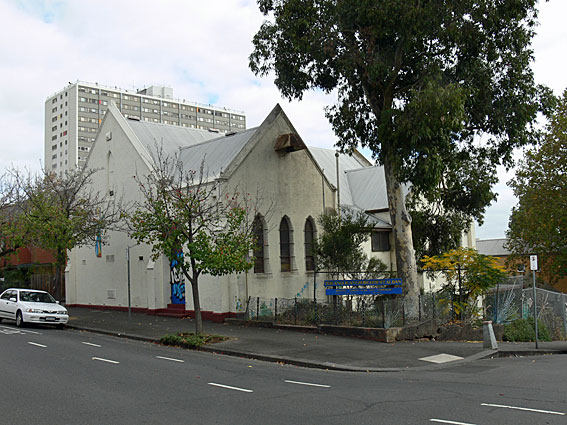
St Alban's Anglican Church, North Melbourne: exterior
[photograph by John Maidment (22 April 2016)]
Historical and Technical Documentation by John Maidment
© OHTA, 2016 (last updated April 2016)

St Alban's Anglican Church, North Melbourne: exterior
[photograph by John Maidment (22 April 2016)]
The foundation stone of St Alban's Church was laid on 23 September 1916 by the Archbishop of Melbourne.1
This single manual chamber organ is of English origin. The design of its classical-style casework would date it from the mid-19th century. It has no identification of builder. It was located at Beechworth Town Hall, in north-eastern Victoria, where it was first used in a concert on 20 December 1886.2 It is understood to have been supplied secondhand and installed by William Anderson, who placed an organ in Christ Church, Beechworth in the following year. It is shown in a photograph taken during a concert at the Town Hall, sited in front of a massive door pediment. It remained in Beechworth until 1910.

Beechworth Town Hall
[photograph from the local museum collection]
The organ was then placed at St James's Anglican Church, Dandenong for about 20 years from 1910 until it was displaced by the Gray & Davison organ from St Patrick's Cathedral, Ballarat in 1931.
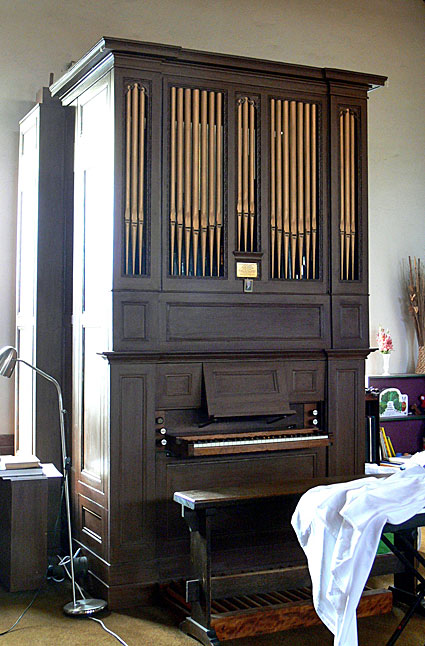
St Alban's Anglican Church, North Melbourne: organ
[photograph by John Maidment (22 April 2016)]
It is then understood to have been installed at St Alban's Church. C.W. Andrewartha made alterations to the Pedal Organ in the 1930sIt was fully restored in 1988 by Australian Pipe Organs Pty Ltd at which stage the organ was moved from an alcove to the left of the chancel to a position in the north transept. The swell shutters, swell pedal, blowing pedal and composition pedals were removed. Thick dark varnish was removed from the organ case and the woodwork refinished. The dummy wooden façade pipes, covered in blue paint, were gilded, and the action and pipework overhauled. The pedalboard appears to be an addition, with the organ raised on a plinth to accommodate it while the Bourdon was added by C.W. Andrewartha; the casework has been extended at the sides to accommodate the addition. The oak keyboard with scrolled cheeks appears to have originally been retractable. The openings in the upper organ case have delicate carved edges.
| MANUAL Open Diapasion (sic) Stopd Diapason Bass Clarabella Treble Keraulophon Principal Fifteenth PEDAL Bourdon |
[8] [8] [8] [8] [4] [2] 16 |
TC CC-BB TC TC permanently on, 12 pipes + 17 from Stopd Diapason and Clarabella |
Pedals permanently coupled to manual
Compass: 56/29
Mechanical key & stop action
2 wooden composition pedals (removed 1988)
Lever swell pedal (removed 1988)
Iron blowing pedal and aperture for blowing handle (removed 1988)4
1. Foundation stone of church
2. Ovens and Murray Advertiser, 18 December 1886, p.4
3. E.N. Matthews, Colonial Organs and Organbuilders. Carlton: Melbourne University Press, 1969, p.141
4. Specification and other details noted by John Maidment 1966, 1988
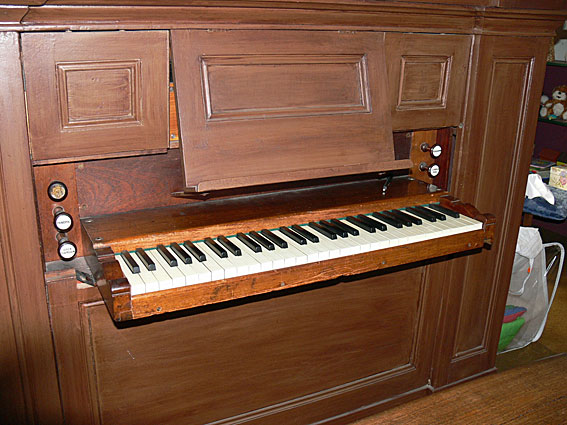
St Alban's Anglican Church, North Melbourne: console
[photograph by John Maidment (22 April 2016)]
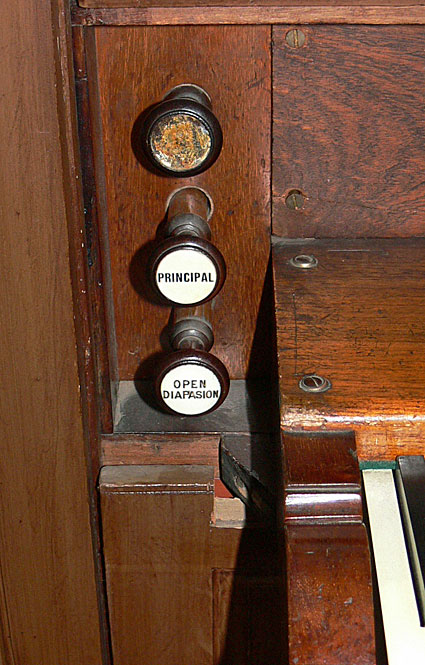
St Alban's Anglican Church, North Melbourne: left jamb
[photograph by John Maidment (22 April 2016)]
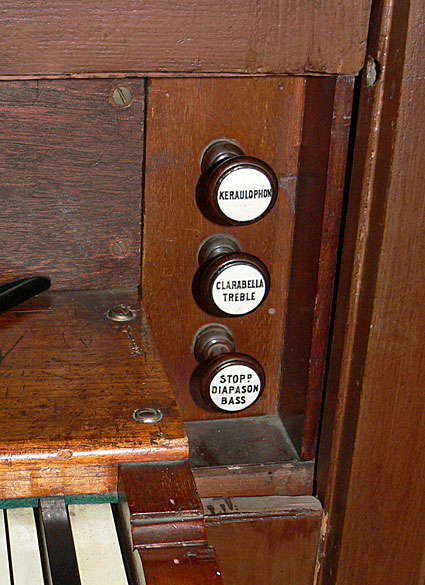
St Alban's Anglican Church, North Melbourne: right jamb
[photograph by John Maidment (22 April 2016)]
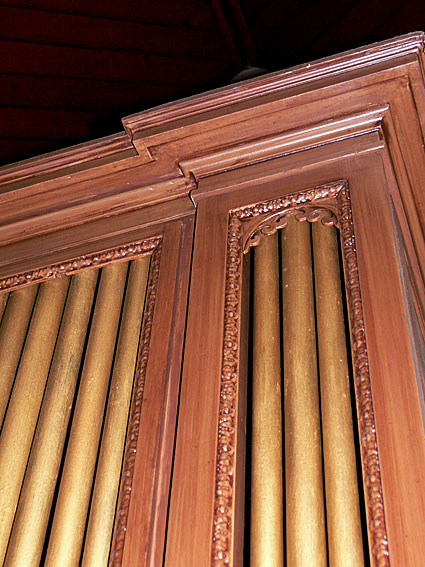
St Alban's Anglican Church, North Melbourne: case detail
[photograph by John Maidment (22 April 2016)]
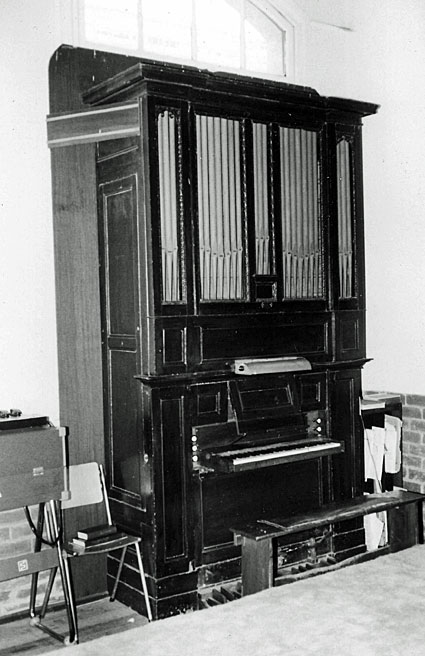
St Alban's Anglican Church, North Melbourne
[photograph by W.G.S. Smith (c.1970)]
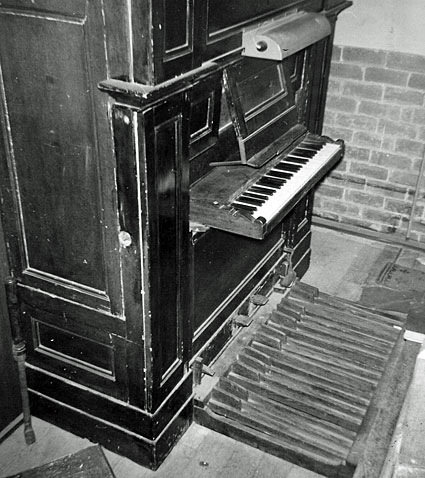
St Alban's Anglican Church, North Melbourne: console detail
[photograph by W.G.S. Smith (c.1970)]